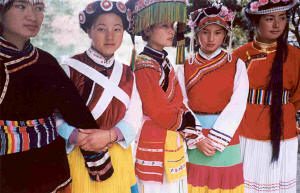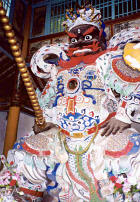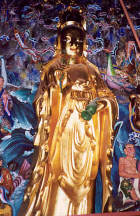Kunming, Yunnan Province
If Shangri-la is in Asia, its antithesis is LAX or Los Angeles International Airport. Of all the airports we encountered, LAX took the prize for longest lines at security checks. On a Monday before Thanksgiving, the pandemonium resembled a typical airport scene in New Delhi. Security agents relieved us of our aerosol mosquito spray. However, my supposedly lead-lined film bag slipped through without question.
Once we firmly ensconced ourselves in our Cathay Pacific seats enroute to Hong Kong, we started to relax. Travel is always a risk, but then, everyday you climb into your car to drive to the grocery store is a risk. I wonder how many people in the World Trade Center disaster had been dreaming about their next vacation. Or had never found the time to travel.
I wish we could be the eyes and the ears for the dead. Sometimes, I can almost believe it’s possible. If I think hard and long about a particular spirit, why shouldn’t he or she be able to share our trip? From Heaven’s point of view, it would enable many of us to live the dreams that our own lives on Earth, cut too short, didn’t allow.
Chris and I have visited China three times in the past eight years. Each time we say this will probably be our last trip – until we hear about another province – another river – another temple – another wonder that lures us back. We try to justify these return visits (there are so many parts of the world we haven’t visited) by adding on countries. In 1998, we flew from Tibet to Nepal, crossing over the top of Mount Everest. This past October, we flew from Kunming to Bangkok, and from Bangkok to Myanmar, Cambodia and Vietnam.
It makes good sense visiting neighboring countries when you’re in Yunnan province because some of the same ethnic groups exist across the border. Yunnan’s ethnic diversity was a major reason for choosing this province to visit. There are twenty-four separate ethnic groups in the province. The Naxi people in Lijiang are most famous for the Dongba pictographic language which has been preserved for centuries. The Mosu have a matrilineal society where women hand down property from mother to daughter. Women do not marry, nor is monogamy necessary (sounds like a pretty good deal, heh?).


Lijiang ethnic groups
Part of the pleasure of traveling in Yunnan is the way local dress changes in color and hue. Women’s headdresses vary according to their ethnic group. And fortunately, some women continue to wear their ethnic dress to market. (Kunming women, on the other hand, wear fashionable shoes, and have a good sense of style with plenty of choices judging by the shop windows).
Likewise, food spices and specialty dishes adjust to the change in temperature and availability of local produce. Some of the dishes we encountered ranged from Kunming’s soups to Lijiang bean curd, Naxi pancakes, and yak meat in Zhondian.
But I’ve jumped ahead. For fourteen hours, enroute to Hong Kong, we sat in our economy seats next to a seventeen-year-old named Sintand from Bakersfield, California. He was making his first trip to the Punjab with his grandmother who was born in India. He told us how things have changed for his family in Bakersfield since 9-11.
“My Dad had to stop wearing his turban (the Sikhs living in the Punjab region of India wear turbans). Some women in the neighborhood had bags pulled out of their hands when they went grocery shopping. They’re afraid to go out of their house. Kids throw stones at my family’s home.” he said in an even-tempered voice.
I wondered how he could speak so calmly. I had already read about a Sikh who had been murdered in Texas. We said ‘good-bye’ at Hong Kong where Sintand would change planes for Delhi and catch a bus for ten-hour ride to the family’s hometown.
Arrival in Hong Kong
Each year we’ve visited Hong Kong, more and more skyscrapers sprout like mushrooms, new skyscrapers replacing the old at a frantic rate.
Hong Kong’s evening light show of neon red and blue bridges enthralled us as we zipped over the bridge connecting Lantau Island to Kowloon. The airport shuttle to the Royal Pacific Hotel is pricey ($160 Hong Kong) but one can also take the tube directly from the Chek Lap Kok (aka “Check Lap Top”) airport to Kowloon.
The Royal Pacific is ideal for serious sleep recovery. It’s easy to close your eyes for a moment and forget in what city or country you’ve alighted. It overlooks the hydrofoil ferry service and its lobby is attached to a huge shopping complex (no city capitalizes on impulse shopping like Hong Kong) My only advice is to get out of town ASAP or you’ll be broke before you’re trip begins!
In the morning, we picked up another can of aerosol mosquito repellant, curious to see how many security checks would let the bug spray slide.
In the restaurants and lobby we saw few Americans and fewer Americans on our two-hour flight from Hong Kong to Kunming aboard China Southern Air. The one American couple appeared to be speaking Chinese fluently so that made us the only ‘gringos’ aboard.
Kunming, Yunnan Province
Kunming is the capital city of Yunnan Province, with a population of approximately 2.5 million, located in southwestern China bordering Myanmar, Laos and Vietnam. Although we were primarily using Kunming as a stepping stone to get to Lijiang (or Shangri-la #1), we were in for a treat. Perhaps because our visit coincided with an important tourism conference, the city was decked out with flowers at every turn. Voted one of China’s cleanest cities, Kunming deserved its title. Our guide, Jackie, spoke honestly about challenges that remained, particularly the canal running through town.
“It’s cleaned three times a week, but that’s still not enough!”
The big push for tourism in Yunnan Province also appears to be bringing more attention to preserving the natural beauty and creating a clean environment. As more tourists visit the region, this will be the big issue. Will more tourism help or hinder Yunnan’s environment and unique cultural heritage?
During our first evening walk in Kunming, we noticed that drivers actually paid attention to traffic lights. We crossed streets with relative ease which wasn’t the case in some of China’s larger cities. The streets were well-lit, and, like Hong Kong, high-rises, not just office buildings but also private residences, dominated the town center.
We were walking past a guarded apartment building not far from the flower market when a grade-school girl walked up to us with her hula hoop. “Hello!” she greeted us in well-enunciated English.
We replied and she looked squarely at Chris. “How old are you?” she asked. The apartment guard who had been watching the exchange began to smile.
Kunming’s flower market overwhelmed us with its explosion of color and scent. The silk flower displays often outshone real bouquets. Vendors outdid one another with their mastery of delicate pastels, swirling bouquets looking almost like dream images come to life. Rather than trying to imitate nature, these artists sweetened reality with sparkles and ethereal cotton candy puff arrangements that would not even weigh down angel’s wings.
“I never realized how skillful the Chinese are at using color,” Chris admitted (and Chris is not the type who notices colors).
After the flower market, the second most important quest was finding a bowl of “Crossing the Bridge Noodle Soup”, a Kunming specialty. What makes “Crossing the Bridge Soup” so special is the sizzle.
Long ago, a Kunming woman used to carry a bowl of soup across the bridge every day to her husband who was studying to pass a civil service exam. By the time she found her husband, the soup was cold. She discovered a way of putting sizzling hot oil into the soup that would continue to sizzle until she had crossed the bridge.
Jackie took us to a local restaurant. Our waitress brought raw pork, fish, chicken plus vegetables that we added to the bubbling broth. This was a meal in itself. Don’t go to Kunming without trying this soup!
Sites in and around Kunming
Most visitors coming to Kunming visit the Stone Forest located about 79 miles to the southeast. The Stone Forest is famous for its unusual rock formations similar to the mountains surrounding Guilin.


Sanqing Taoist temple
![]()
![]()
However, rather than using one entire day for this excursion, we preferred to visit some of the temples closer to Kunming as well as the Yunnan Provincial Museum. We started with the Sanqing Temple, a Taoist shrine which overlooks Dianchi Lake. Sanqing is tucked into the side of the Western Hill, actually four mountains that border the lake.
After the first dozen steps carved into rock, I realized what a good idea it had been to do some endurance training before this trip. Anyone considering a trip to China should really think about doing some sort of aerobic exercise for at least a month before departure. Being able to walk up and down steps is a necessity in this part of the world. I would suggest running or walking a 5km at least two to three times per week to prepare for your trip. Don’t leave home without: A strong pair of legs, plenty of kleenex and a good supply of Immodium (if you are staying in China or Southeast Asia for more than a week).
Sanqing is not exactly a serene retreat – we found ourselves inching our way up winding stone staircases toward various shrines culminating in the Dragon Gate (with many stops to touch spots for good luck) along with a steady stream of tourists from various parts of China. But that’s part of the fun. Everyone at one point or another stopped to marvel at the view as if we were eagles perched on this rocky precipice that plunged into Dianchi Lake’s blue waters.
We also visited the Buddhist temple, Huating, which is less crowded allowing plenty of time and elbow room to admire its garden and lake in tranquility. Here, the trees were labeled according to their names in Chinese and in English.
Matthew, our driver, found a clearing in the park where he demonstrated some meditational exercises. Aside from being a talented photographer, we discovered that Matthew studied “Yun Gong” or “Yunnan Indigenous Mimicking Gong”. (another good reason to think about visiting Kunming!)


Guanyin, the Goddess of Mercy
![]()
![]()
At Taihua Temple, a statue dedicated to Guanyin, the Goddess of Mercy watched over us as we exited. Her image reappeared often in our travels from China to Vietnam to Myanmar.
At the Yunnan Provincial Museum, the guard told us we were lucky. “The bronze drums just came back from a traveling exhibit. These ceremonial bronze drums (400 B.C.) are still used for Harvest Festivals (June 6th) and Chinese New Year.
One of the drums depicted long boats with rowers sporting feathered headdresses. Other drums featured swirling geometric patterns – all of which made me wonder about the theory of the Bering Sea land migrations which supposedly took place thousands of years earlier. Wouldn’t it be just as feasible for these fifth century navigators to take their simple boats as far as the New World?
After having visited the temples of Luxor and the temples of China, I am amazed at the similarities in layout, and placement of inner buildings according to function. Also, whether we are in South America, Egypt, or Kunming, sooner or later one is bound to find a tribute to the sun. In Kunming, two “golden towers” were constructed in the center of town so that at a particular time, the sun’s light would hit both towers – and that is the time to make a wish. The more we travel, I find it harder to believe that Egypt, parts of South America and China were not exchanging ideas to a far greater extent than what we have recorded to date. But I must leave these questions to the archeologists and the scholars.
At Sanqing Temple, a fresco depicts several gods in a boat with the waves of the South China Sea thrashing all about them. Jackie explained, “Even the gods need to cooperate against adversity.”
We left Kunming with the image of the gods traveling together, combining all their magical forces to brave the unknown. For us to be able to fly to “Shangri-la” or Lijiang in a China Yunnan Airbus seemed much too simple in comparison.
An instrumental version of “Ave Maria” permeated the plane’s cabin. Getting to beautiful places should demand more effort. I am worried about this being too easy. But then, I am learning that any trip to China starts with baby steps. Lijiang is the welcoming beacon to Shangri-la. But it doesn’t mean we’re there yet!